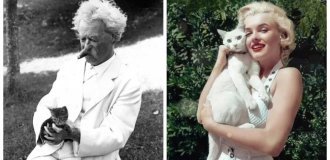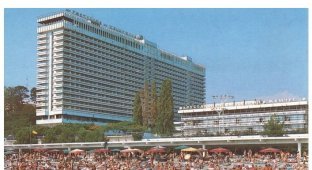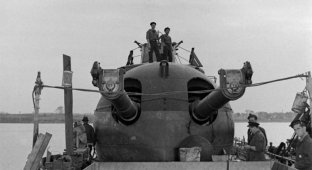The first nuclear submarine of the Soviet Union (2 photos + description)

Shortly after the Christmas holidays in 1959, Admiral Ralph posted the following notice at the entrance to his office: “I, Commander, United States Atlantic Fleet, promise a case of Jack Daniels whiskey to the first submarine commander who presents proof that an enemy submarine has been exhausted by pursuit and has been forced to surface.” " This wasn't a joke. The admiral, as if on a racetrack, bet on the miracle of American military thought - the nuclear submarine. The modern submarine produced its own oxygen and was able to remain underwater throughout the entire voyage. Soviet submariners could only dream of such a ship. During a long voyage, their crews suffocated, the submarines were forced to surface, becoming easy prey for the enemy.
The winner was the crew of the submarine USS Grenadier, tail number SS-525, who pursued the Soviet submarine for about 9 hours and forced it to surface off the coast of Iceland. The commander of the US submarine, Lieutenant Commander Davis, received the promised box of whiskey from the admiral's hands. They had no idea that very soon the Soviet Union would present them with its gift.
In 1945, the United States openly demonstrated to the world the destructive power of its new weapons, and now it must have a reliable means of delivering them. By air, as was the case with Japan, it is associated with great risk, which means that the only reasonable way to deliver nuclear cargo should be a submarine, but one that could secretly, without ever surfacing, deliver a decisive blow; a nuclear submarine was ideal for this. Creating such a submarine was a daunting task at that time, even for the United States. Less than a year later, the first nuclear-powered icebreaker USS Nautilus, tail number SSN-571, was laid down at a shipyard in New London, Connecticut. The project was implemented in an atmosphere of such extreme secrecy that intelligence information about it reached Stalin’s desk only two years later. The Soviet Union again found itself in the role of catching up. In 1949, the first Soviet atomic bomb was tested, and in September 1952, Stalin signed a decree on the creation of nuclear submarines in the USSR.
Domestic designers, as happened more than once, were forced to go their own way, as circumstances were difficult for the Soviet Union in general and for Soviet military science in particular. In the USSR, defense work was always headed by people unknown to the general public, who were not written about in the newspapers. The creation of the submarine project was entrusted to the designer V. N. Peregudov. The technical design of the first nuclear submarine was approved.
Technical characteristics of the Project 627 nuclear submarine “K-3”, code “Kit”:
Length - 107.4 m;
Width - 7.9 m;
Draft - 5.6 m;
Displacement - 3050 tons;
Power plant - nuclear, power 35,000 hp;
Surface speed - 15 knots;
Underwater speed - 30 knots;
Immersion depth - 300 m;
Navigation autonomy - 60 days;
Crew - 104 people;
Weapons:
Torpedo tubes 533 mm: bow - 8, stern - 2.
The idea for the combat use of a submarine was as follows: a boat armed with a giant torpedo is towed from its home base to the dive point, from where it continues to sail underwater to a given area. Upon receiving the order, the nuclear submarine fires a torpedo, attacking enemy naval bases. During the entire autonomous voyage, the nuclear-powered vessel is not planned to surface, and no means of protection or countermeasures are provided. After completing the task, she becomes practically defenseless. An interesting fact is that the first nuclear submarine was designed and built without the participation of the military. The submarine's only torpedo with a thermonuclear charge had a caliber of 1550 mm and a length of 23 m. It immediately became clear to the submariners what would happen to the submarine when this super-torpedo was launched. At the moment of launch, the entire mass of water will be fired along with the torpedo, after which an even larger mass of water will fall inside the hull and will inevitably create an emergency trim. To level it, the crew will have to blow out the main ballast systems and an air bubble will be released to the surface, allowing the nuclear submarine to be immediately detected, which means its immediate destruction. In addition, specialists from the Navy General Staff found that not only in the United States, but throughout the world there are only two military bases that can be destroyed by such a torpedo. Moreover, they had no strategic significance.
The giant torpedo project was buried. Life-size mock-ups of the equipment were destroyed. Changing the design of a nuclear submarine took a whole year. Workshop No. 3 became a closed production facility. Its workers did not have the right to tell even their relatives where they worked.
In the early 50s, hundreds of kilometers from Moscow, the GULAG forces built the first nuclear power plant, the purpose of which was not to produce electrical energy for the national economy - it was a prototype of a nuclear installation for a nuclear submarine. The same prisoners built a training center with two stands in a pine forest. Over the course of six months, all the fleets of the Soviet Union recruited the crew of the future nuclear submarine, long-term sailors and officers. Not only health and military training were taken into account, but also a pristine biography. Recruiters had no right to utter the word atom. But somehow, in a whisper, rumors spread where and what they were invited to. Getting to Obninsk became a dream. Everyone was dressed in civilian clothes, the military chain of command was abolished - everyone addressed each other only by their first names and patronymics. The rest is strictly military order. The personnel were painted as on a ship. The cadet could answer anything from strangers, except that he was a submariner. It was always forbidden to pronounce the word reactor. Even during lectures, teachers called it a crystallizer or apparatus. The cadets practiced a variety of actions to escape the release of radioactive gas and aerosols. The most significant problems were fixed by the prisoners, but the cadets also had their share. Nobody really knew what radiation was. In addition to alpha, beta and gamma radiation, there were harmful gases in the air, even household dust was activated, no one thought about it. The traditional 150 grams of alcohol was considered the main medicine. The sailors were convinced that this was how they removed the radiation picked up during the day. Everyone wanted to go sailing and were afraid of being written off even before the submarine was launched.
























